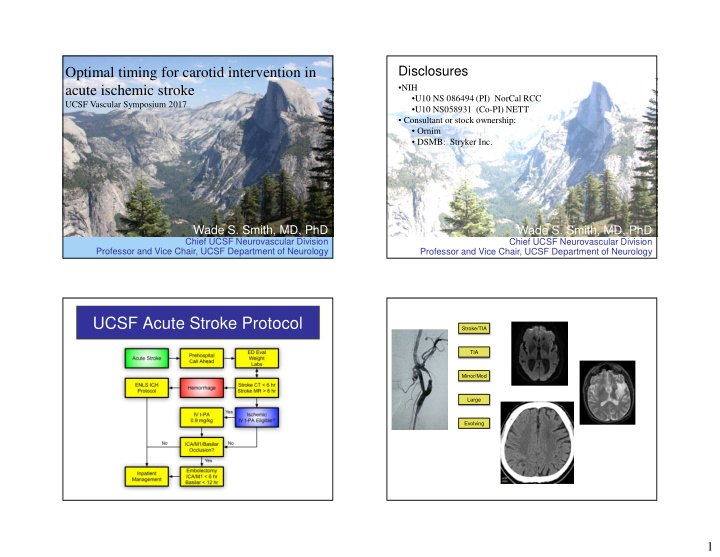



Disclosures Optimal timing for carotid intervention in •NIH acute ischemic stroke •U10 NS 086494 (PI) NorCal RCC UCSF Vascular Symposium 2017 •U10 NS058931 (Co-PI) NETT • Consultant or stock ownership: • Ornim • DSMB: Stryker Inc. Wade S. Smith, MD, PhD Wade S. Smith, MD, PhD Chief UCSF Neurovascular Division Chief UCSF Neurovascular Division Professor and Vice Chair, UCSF Department of Neurology Professor and Vice Chair, UCSF Department of Neurology UCSF Acute Stroke Protocol Stroke/TIA TIA Minor/Mod Large Evolving 1
Stroke/TIA Stroke/TIA TIA TIA Minor/Mod Minor/Mod Large Large Evolving Evolving 891 patients with symptomatic ICA stenosis; CEA < 48 hours in 176 TIA- 1.8% stroke Crescendo TIA- 0% Stroke in Evolution – 7.6% Stroke/TIA TIA Minor/Mod Large Evolving 62 patients with symptomatic ICA stenosis; CEA mean 34 hours 90 patients with symptomatic ICA stenosis; CEA (13-117 hours) NIHSS scores ranged from 4-15 27 TIA patients: 0% stroke No post-operative stroke; all had decrease in NIHSS score 52 Mild/Moderate Stroke: 5.8% stroke 11 Stroke in evolution: 27% stroke 2
Unadjusted Kaplan–Meier Event Curves for Stroke Recurrence from the Time of the Qualifying Event to 1 Year. Original Article One-Year Risk of Stroke after Transient Ischemic Attack or Minor Stroke Pierre Amarenco, M.D., Philippa C. Lavallée, M.D., Julien Labreuche, B.S.T., Gregory W. Albers, M.D., Natan M. Bornstein, M.D., Patrícia Canhão, M.D., Louis R. Caplan, M.D., Geoffrey A. Donnan, M.D., José M. Ferro, M.D., Michael G. Hennerici, M.D., Carlos Molina, M.D., Peter M. Rothwell, M.D., Leila Sissani, B.S.T., David Školoudík, M.D., Ph.D., Philippe Gabriel Steg, M.D., Pierre-Jean Touboul, M.D., Shinichiro Uchiyama, M.D., Éric Vicaut, M.D., Lawrence K.S. Wong, M.D., for the TIAregistry.org Investigators N Engl J Med Volume 374(16):1533-1542 April 21, 2016 Amarenco P et al. N Engl J Med 2016;374:1533-1542 Main Investigation Findings during Evaluation by Stroke Specialist and Key Urgent Treatment before Discharge. The risk of recurrent stroke … was less than half that expected from historical cohorts; for example, the risk of stroke and other vascular events at 90 days in the historical cohorts was 12 to 20% as compared with 3.7% in our cohort. The lower event rates … may be explained by better and faster implementation of secondary stroke prevention strategies (e.g., immediate initiation of antiplatelet drugs, oral anticoagulation in the event of atrial fibrillation, urgent revascularization in patients with critical carotid stenosis , and other secondary prevention measures such as treatment with statins and blood-pressure–lowering drugs) in contemporary TIA clinics than in settings where Amarenco P et al. N Engl J Med 2016;374:1533-1542 historical cohorts received care. 3
Thank You Carotid-T, M1 occlusions • Level 1 Evidence for acute T/M1 Embolectomy during AIS • Time window is expanding University of California, San Francisco 4
Recommend
More recommend